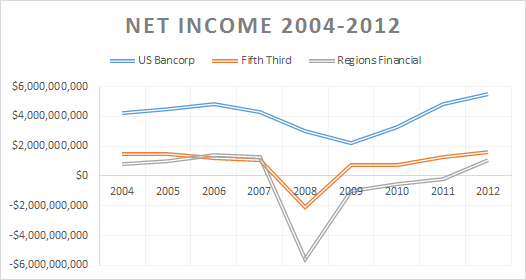Warren Buffett's single greatest piece of wisdom and advice, at least in this investor's opinion, is this: When buying a stock, imagine you're buying the whole business.
In Buffett's 1988 letter to Berkshire Hathaway (NYSE: BRK-A) (NYSE: BRK-B) shareholders, the Oracle of Omaha listed his six criteria for buying a business. Could great investing really be about following those six steps? Let's put this theory to the test.
Today, I'm going to use Buffett's six essential criteria for buying a business to help better analyze regional banks U.S. Bancorp (USB +0.92%), Fifth Third Bancorp (FITB +1.33%), and Regions Financial (RF +1.95%).
Step 1
Large purchases (at least 10 million of after-tax earnings).
| Company | Net Income |
|
U.S. Bancorp | $5.4 billion |
| Fifth Third | $1.5 billion |
| Regions Financial | $990 million |
According to 2012 earnings, displayed in the chart above, all three of the banks pass the first qualifier with earnings well over Buffett's $10 million after-tax mark. As a rule of thumb, stick to established businesses; remember, many of the best investors are the best at avoiding risk, not picking the best start-ups.
Step 2
Demonstrated consistent earning power (future projections are of little interest to us, nor are "turnaround" situations).

While stock market crashes are never good, they can give investors a good opportunity to judge a company's stability. In the chart above, for instance, if 2008 was excluded, Regions Financial and Fifth Third would look like really consistent earners. Since the crash did in fact happen, it cements U.S. Bancorp as the leader of this group in consistent earnings.
Step 3
Businesses earning good returns on equity while employing little or no debt.
| Company | ROE | Leverage | Tier 1 Capital |
| U.S. Bancorp | 13.9% | 9.1 | 11.2% |
| Fifth Third Bancorp | 12.8% | 8.9 | 11.1% |
| Regions Financial | 7.7% | 7.8 | 11.5% |
Source: Yahoo! Finance and company filings.
When judging return on equity for a bank, anything from 10% to 15% is good. Ratios above that mark are fantastic, as long as the company isn't getting overly aggressive with loans.
Leverage refers to the amount of assets the bank takes on against its equity. The more leverage, the more profits and losses are magnified. Tier 1 capital valuable for making sure banks are sufficiently capitalized to cover losses. Regulators consider a bank well capitalized after 6%. According to the chart above, all three nearly double that mark.
For the three banks being discussed, none is leveraged to a worrisome level, and I'd guess they'd pass Buffett's sniff test -- though Regions may get docked some points for the low ROE.
Step 4
Management in place (we can't supply it).
Since we're discussing buying stock and not businesses, Buffett might amend this step to something more like, "Strong management in place (we won't buy without it)."
In my view, all three banks, at least at the CEO level, have strong leadership. Richard Davis at U.S. Bancorp, Kevin Kabat at Fifth Third, and Grayson Hall at Regions Financial all have 30-plus years of experience in banking. Banking is a tough business for an industry outsider to swoop in and lead, so I view multiple decades of experience as a definite plus.
Step 5
Simple businesses (if there's lots of technology, we won't understand it).
In recent years, banks have been viewed as particularly complex, but that hasn't stopped Buffett and Berkshire Hathaway from loading up on Wells Fargo (WFC +2.31%). Wells Fargo and many other banks -- including the ones we've been discussing here -- aren't nearly as complex as other global megabanks and investment banks. Further, investors don't need to be able to manage the bank, just understand its functions enough to notice red flags and be able to identify good managers.
At a high level, Buffett's point here is to invest in companies you understand. So we can't necessarily say that any of the three banks fit this step or not -- that will depend on the particular investor considering them.
Step 6
An offering price (we don't want to waste our time or that of the seller by talking, even preliminarily, about a transaction when price is unknown).
Since we're buying stocks and not actually buying businesses, we'll be more worried about finding a fair price, and one of the simplest ways to determine this is by comparing similar businesses. For financials in particular, price-to-book value works well.
| Company | Price-to-Book |
| US Bancorp | 2.1 |
| Fifth Third | 1.3 |
| Regions Financial | 0.9 |
Source: Yahoo! Finance.
The average company in the financial sector, according to Yahoo! Finance, trades at 1.6 times book, and the average price-to-book value for regional banks, which varies a bit by region, has a low of 1.6 in the southeast and a high of 2.3 in the southwest.
U.S. Bancorp has proven its place at the table, while Regions Financial and Fifth Third have some work to do yet, but for investors high on Fifth Third or Regions Financial, the low multiple should look like a nice discount.
What Would Warren Do?
If Warren Buffett was to truly analyze these banks, which I'd guess he has, chances are Fifth Third and Regions Financial would've never made it past step two (the stability step). The companies did, however, do well in most of the other categories. But considering Buffett is a fan of buying fewer stocks rather than many, why not simply buy the best?
That should make it no surprise that Buffett and Berkshire Hathaway currently own zero shares of Regions and Fifth Third, and more than 79 million shares of U.S. Bancorp.
